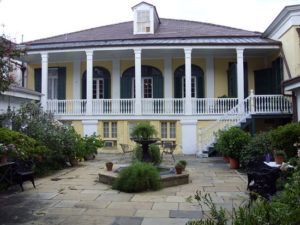Although it might be the architecture of 1113 Rue Chartres that slows your steps and catches your eye, it is the history of the property that reels you in, peaking your curiosity. Back in the early eighteenth century, the Beauregard-Keyes House was actually intended to be a weapons arsenal for the budding city of New Orleans. Plans switched however when the Ursuline nuns arrived from France in 1726, and the King of France signed the whole block over to the nuns instead.
The land stayed religious until 1825 when it was bought and the current structure erected. Some years later, in 1865, Dominique Lanata bought the property. Lanata was a grocer in the French Quarter, and also the Consul-General of Sardinia in New Orleans, and he saw 1113 Chartres as a fine investment property. He’d rent it out making good money, which he did until 1904.
Lanata’s first tenant sealed the fate of the property; his name was Pierre Gustave Toutant Beauregard, and he was considered of the first and most respected generals of the Confederate Army. Beauregard had commanded troops in the Western Theatre. He’d fought in the Battle of Bull Run, the Battle of Shiloh and the Siege of Corinth, Mississippi. But the general had done even more for his beloved Confederacy: in 1864, Beauregard helped to save the city of Petersburg, Virginia, which, if he’d failed, would have allowed Union troops a clear passage to the Confederate capital of Richmond, Virginia.
Disregarding the fact that General Beauregard had only lived in the home as a tenant, locals began to refer to the property as the Old Beauregard House. One has to wonder how Dominique Lanata felt, or whether he’d simply been pleased to have a first class general living under his roof for eighteen months.
The Beauregard-Keyes House had a few tenants after the passing of the general, but nothing would prepare the neighbors for what happened in 1904. The Lanatas sold the house to the Giacona family just after the turn of the century, all of whom were involved with a liquor business. A wholesale liquor business, if you get what I’m saying. They operated as a wine cellar on the first floor and for the first few years while living in the Old Beauregard House, the Giaconas lived lavishly. Rumors began to spread that perhaps not all was what it seemed at the mansion on Chartres. The Sicilian Black Hand (a sect of the mafia in New Orleans) felt that the Giaconas were impeding on their territory and that perhaps weren’t paying their dues. The name “Black Hand” referred naturally to their less than gracious extortion methods.
Pietro Giacona, the patriarch of the family, issued an invitation to four of the members of the mob. It was also he that issued their death. In the middle of the dinner, the Giaconas stood, grabbed their pistols and opened fire. Three of the Black Hand dropped to the floor lifeless, while the fourth was gravely injured. He somehow managed to escape but he did not get far, crawling as he was finished off on the cobble stoned streets outside. The assassinations had been conducted with Pietro’s two young daughters just down the hall in their bedrooms.
The Black Hands are said to haunt the premises, with the one who nearly escaped crawling away for safety nearly nightly. On more than one occasion unsuspecting passersby have rushed to the aid of a wounded gentleman only to find he had vanished by the time they crossed the street.
After the murders the Giacona men fled leaving the women behind to fend for themselves (classy). The youngest daughters sewed children’s clothes and sold them in the French Quarter as a means of survival.
Shortly after, the property fell into disrepair and was up for demolition until in 1945 when writer Frances Parkinson Keyes moved in and began renovations. She re-added the parterre garden and restored the home to its former glory. It was here that she penned thirty novels, including Dinner at Antoine’s and The Chess Players. Keyes wintered at the property until her death in 1970. And since then the Keyes Foundation has operated the property as a museum.
Keyes is another lingering resident that guests and visitors have witnessed. She has been seen wandering through the home going about her day to day routine paying no attention to anyone around.
The reports of seeing Civil War soldiers are seemingly endless while the sound of gunfire on the wind is more than common. On nights when the spirits are especially restless, the pungent smell of blood and death fill the air around the property.
While the house was said to have possessed one previous resident sending him into madness, Ms. Keyes never felt the entities around are dark enough to cause such a thing. If at any point, you’d like to test her theory and see for yourself, the home is a working museum and can be visited seven days a week.
Good luck…
When Kristi isn’t writing for NewzBreaker, she writes supernatural suspense novels having three currently published. If you would like to check out any of her books they can be found online and at other major retailers like Books a Million and Amazon. Never one to rest, she also paints/designs shoes and items for the home. Check out her eBay store, Watered Down Vodka and her FB page.
[si-contact-form form=’3′]

 February 21st, 2017
February 21st, 2017  CEO
CEO 
 Posted in
Posted in  Tags:
Tags: 



